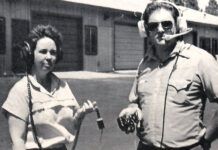 The connector in the left photo was discovered on the back of an autopilot control head that was intermittent. D-subs require a backshell (right photo), which provides the mechanical connection from the connector to the device through the screws. Without the backshell, the connector will eventually become loose and perhaps even completely disconnect from the device.
The connector in the left photo was discovered on the back of an autopilot control head that was intermittent. D-subs require a backshell (right photo), which provides the mechanical connection from the connector to the device through the screws. Without the backshell, the connector will eventually become loose and perhaps even completely disconnect from the device.














Requires screws to hold it in place, not necessarily a back shell if the shrink tubing provides adequate wire relief.
Why do you publish such misleading info?
Yes, the screws are required to hold it in place. I don’t think it is misleading information. Heatshrink can and will come loose over time the way it is depicted in this picture. The wires should be mechanically supported so that they do not flex and work over time, causing breakage of the conductor. Perhaps in a non-aircraft, low vibration environment you might get away with it. But in ana aircraft, on a major system like an autopilot, I really think it is poor practice.
Vic
You correctly identified missing screws as the reason the connectors came apart. A back shell, with its screws, conveniently provides wire support and ensures connectors do no come apart. But a back shell may not be the solution in some cases where there is no room for it. What is required: something to ensure connectors do not come apart (usually screws but zip ties cannot be ruled out) and something to ensure that wires are supported.
My objection is to absolute statements like “D-subs require a backshell”.
They make 90 degree backshells for areas where there is not room for a straight backshell. In all of the aircraft I have worked on, including military and commercial, I have not seen where there is not enough room for either a straight backshell or a 90 degree one. I know I haven’t seen everything in life yet, but we are trying to rpovide guidance to builders of homebuilt aircraft. Backshells should be used. Perhaps someone can come up with a valid example of where there is not room, but then I bet there is not enough room for the heat shrink to proved the necessary support either. I will also bet that any example with be a real outlier. I stand by my statement. You are welcome to your opinion. 🙂
The backshell is “best practice” but by no means “required” – just like a screw is “best practice” but a wire tie or two can also be acceptable. A properly sized and applied heat shrink CAN also be acceptable in place of a back-shell – if properly installed. Not 100% sure I like the pictured installation as it does NOT appear to provide adequate retention. The heat shrink should be applied right up to the “flange” to provide maximum “grip” on the shell. It also does NOT provide full stain relief as the heat shrink does not have any “grip” on the wires/cable. Filling the heat-shrink “tail” with an adhesive caulk could/would address the strain relief issue if the heat shrink was applied properly to the shell – but in most cases just using the proper back shell would be less hassle – – –
Clare, as I stated, I disagree. I have found way too many failures and intermittents in connectors in airplanes without the backshell connectors on them. I wouln’t call using the connector a “best practice.” It is the recommended way. You might say that your ways are alternative means, and perhaps they could work. I ask, how many have you seen without that connectors and they last? I bet I have seen more failures than you have seen working ones. 🙂 The goal here is to pass along thoughts and ideas to help builders impement the best ways of doing things in thier aircraft to insure some sense of reliability. Alternative ways are OK, when done by an experienced person, or someone who has thought it through or maybe sought out help. I would call those the exceptions, and yes they might work. But overall, it is usually best to stick with the prven, recommended ways.
I am convinced that backshells are the way to go. But I have installed Electronics International engine monitors and instrumentation and EI never uses or supplies backshells or strain relief for their pre-wired Dsub connectors and harnesses. Legacy avionics edge card connectors never use backshells but usually have a small Adel or plastic clamp for strain relief. Those edge card connectors are also not Dsubs and there is no equivalent of a backshell available so this is probably an apples and oranges comparison. The bare EI Dsub connectors have withstood the test of time but certainly backshells could only be better. I tried adding backshells to one one EI install and it was complicated by the way EI imbeds the attachment screws so I gave up and figured EI knew what it was doing. Also I have had no luck finding 90 degree backshells for Dsubs like 50-pin (SD)/78-pin (HD) connectors that are metal or metal plated plastic (with conductive backshells being preferred). On one final note I can’t understand how so many non-Garmin avionics / EFIS manufacturers deliver very expensive products with the cheapest and cheesiest plastic Dsub backshells held together with sheet metal screws into plastic (looking at you UAvionix and Trig). Or worse solder type connectors rather than industry standard crimp contacts. Thanks for a great article.